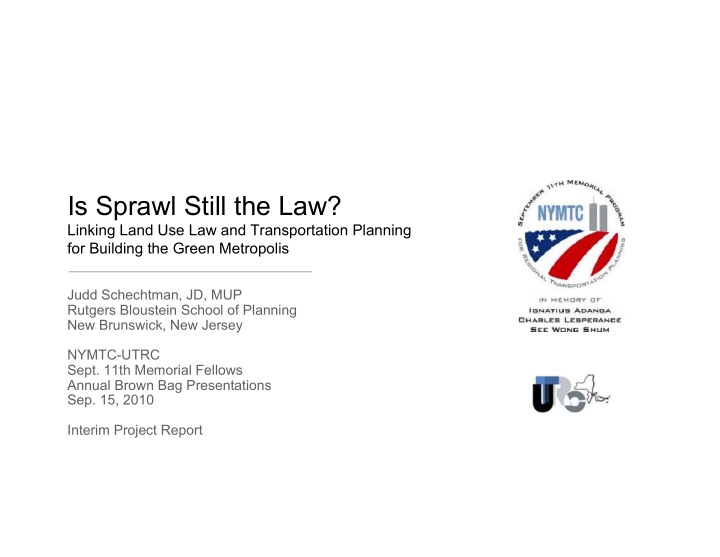



Is Sprawl Still the Law? Linking Land Use Law and Transportation Planning for Building the Green Metropolis Judd Schechtman, JD, MUP Rutgers Bloustein School of Planning New Brunswick, New Jersey NYMTC-UTRC Sept. 11th Memorial Fellows Annual Brown Bag Presentations Sep. 15, 2010 Interim Project Report
Framing the Problem: Post-War dominant land use pattern of sprawl Underutilization of existing transit infrastructure Growth in VMT -> Increased carbon emissions, congestion
TOD and Urbanism Can TOD reduce VMT and associated problems? Nationally, there is a vigorous academic debate Ewing et. al. (2008) claim TOD and smart growth reduce VMT and GHG by 20-40% relative to sprawl Are the numbers the same in NYC?
NY Starts with Advantages Research Supports this Connection to Transportation and Land Use Planning Highest shares of transit use in the nation Highest shar es of transit use in the nation - Winkelman and Diekers (2003) found NY Concentrated CBD Concentrated CBD has the most efficient transportation sector Strong population gr Str ong population growth and housing owth and housing in the nation. demand demand - Newman and Kenworthy (1989) found the low carbon footprint in NY due in large part to transportation infrastructure investments and supportive land use planning that enable high levels of transit use, walking and bicycling. - Polzin (2004) found higher development density is correlated with transit availability, auto availability and operating/parking cost, centrality of location, and urban design features that cater to pedestrians. - Winkelman and Diekers found a significant negative correlation between gasoline use and percentage of population living in the inner city, pre-war, transit-oriented part of the metropolitan area.
Focus on existing transit locations Downs (2004) reports that “efforts at raising densities to reduce traffic congestion are likely to be most successful if they concentrate on...relatively small areas with excellent access to existing public transit service.” Much progress has been made at curbing sprawl through land protection and low-density zoning at the fringe, but redevelopment of our downtowns has been less successful
Research Project 1. Survey state law for most innovative and progressive actions linking transport and land use planning 2. Survey and analyze local plans and zoning law to determine what is the state of TOD in the New York area 3. Answer the question: Is TOD undersupplied in the NY region as evidenced by zoned build out? 4. Rank municipalities cooperation or obstinacy toward TOD
The law and sprawl Since Euclid v. Ambler, courts have read municipal statutes to be the equivalent of legislation - imbued with the deference entitled to public laws Contrary to common perception, sprawl is largely required by law - in the form of density limits, maximum heights, yard setbacks, parking requirements, and minimum lot sizes (Levine 2005)
States set the framework for local planning Enabling acts form the basis of land use and zoning power in every state Acts are largely permissive and focus on local concerns However, despite widespread belief in “home rule,” states can, and have, required municipalities to plan to meet broader objectives for the past 40 years Callies and Bosselman first described this trend as the “Quiet Revolution” in the late 1960’s
States have passed a new generation of Climate Action Laws 32 states have passed legislation requiring a plan to respond to climate change Many more have also set GHG targets Few have passed implementing regulations affecting municipalities and land use
Studied Transit-Area Land Use in the NY Area Working on three primary areas - Westchester, Long Island and NYC Aggregating local land use law in key transportation hubs and downtowns in the three parts of the region Focusing on land use in areas within 1/2 mile of a transit station
Plans for Growth NYMTC Shared Vision & RTP Westchester’s 2025 Plan Together Nassau’s New Suburbia NYC’s PlaNYC
What are we up against? Plans often target specific areas or regions for special- case TOD or smart growth (e.g. the RTP 9 “preferred growth areas”) A sustainable land use system must extend to every city, town and village in the metro area Hypothesis that towns prohibit new mixed use, multi family and dense uses even in their centers How are we doing in that regard?
Focus on Westchester County Map depicting areas zoned for multi-family housing in orange MTA Metro North stops are black dots
Preliminary Findings Efforts are being taken to develop existing TODs - regionally, at counties and in some localities Variety of conditions in towns More restrictive the wealthier and further north Contrary to initial hypothesis, many towns are zoned for MF and mixed use in their cores, Many are taking smart growth, TOD and sustainability planning seriously Lots of talk, less action Many still exclude nearly all new development Will there be a change in the local law to permit additional growth in centers? Avalon Huntington Station “TOD” proposed rendering and site plan. Is this smart growth?
Next Steps Calculation of FAR and Maximum Density Limits Complete town-by-town analysis in Westchester Complete Long Island database, GIS and analysis if possible Complete NYC analysis Propose recommendations: Will likely require coordinated action and a system to incentivize or require smart land use tied to transit service provision
Thank you for your attention! Many thanks to NYMTC & UTRC for funding this work. Special thanks to Ed Buroughs, Robert Burchell and Penny Eikemeyer for your support. Judd Schechtman Rutgers University judds@rutgers.edu
Recommend
More recommend